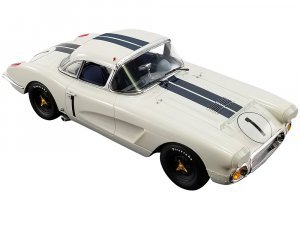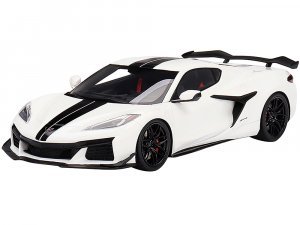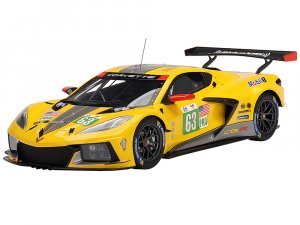Diecast models have been a popular collectible among car enthusiasts for decades, with the Corvette being one of the most iconic American sports cars to grace different manufacturers' shelves. The evolution of Corvette diecast models traces back to the early classic cars that have inspired many automobile enthusiasts over time. Since then, Corvette has undergone several design changes, and its latest models have taken the world by storm. This blog post will take you on a journey through time and explore how these miniature set versions of Corvettes have evolved from classic cars to modern marvels over the years and captured our attention with their unique details and outstanding performance.
Classic Corvette Diecast Models

The first classic Corvette diecast models were introduced in the mid-1950s by companies such as Dinky, Corgi, and Matchbox. These early models typically featured a metal body with plastic parts and were approximately 1:43 scale.
In 1968, Hot Wheels released their first Corvette model, which was based on the iconic Stingray design. This model was highly detailed and realistic for its time, featuring a plastic body with rubber tires and working suspension.
Over the years, numerous other companies have produced diecast models of classic Corvettes from various eras. Some of the most notable examples include Franklin Mint's limited edition Corvette collections, Maisto's detailed replicas of classic Vettes, and Revell's customizable kits for building your own miniature Corvettes.
Today, diecast models of classic Corvettes are highly sought after by collectors around the world. Some of the most popular designs include the Stingray Coupe (1963), Grand Sport (1966), and C1 Convertible (1959). Whether you're a longtime fan of this iconic American sports car or simply appreciate finely crafted miniatures, there's no denying the timeless appeal of these classic Corvette diecast models.
Corvette diecast models have been popular among collectors for many decades. These models come in various scales, from small 1:64 scale models to highly detailed 1:18 scale replicas.
- 1:64 Scale Models - These are the smallest Corvette diecast models and are typically sold in sets featuring multiple cars. They are often less detailed and cheaper than larger-scale models.
- 1:43 Scale Models - Slightly larger than the 1:64 scale, these models tend to feature more detail on both the exterior and interior of the car.
- 1:24 Scale Models - This is a popular size for collectors because it provides a good balance between size and detail. Many Corvette diecast models in this scale feature opening doors, hoods, and trunks.
- 1:18 Scale Models - These are some of the largest and most detailed Corvette diecast models available on the market today. They typically come with working features like opening doors, hoods, and trunks as well as functioning suspension systems.
Apart from the different scales of Corvette diecast models that have been produced over time, there are also different types of these collectibles:
- Street versions- A street version is modeled after stock Corvettes driven on public roads.
- Racing versions- Racing model Corvettes depict actual competitive racing events or special-performance vehicles manufactured specifically for automobile competitions.
- Promotional/Conceptual Versions- There may be promotional concepts related to new model releases that translate into unique design features that could get captured by collectors' car manufacturers.
- Limited Editions- Manufacturers sometimes limit certain series or runs of their production to create exclusivity among their products incentivizing enthusiasts towards making purchases at boutique car shops or online stores online since they serve specifics within a limited edition series created for select distributors only.
Overall, there is no shortage of options when it comes to Corvette diecast models. With different scales and types available, collectors can choose from a variety of models that fit their individual preferences and collections.
Modern Corvette Diecast Models

The transition from classic to modern diecast models was a gradual process that spanned several decades. The Corvette has been an iconic American sports car since its introduction in 1953, and its design has undergone numerous changes over the years.
At the dawn of diecast collecting, most models were produced as simple metal cars with basic details and features. However, as consumers became more sophisticated in their tastes and demands for accuracy grew, manufacturers began to invest in new technologies such as computer-aided design (CAD) and digital scanning to create increasingly realistic models.
As a result, newer generations of collectors have embraced modern-era Corvettes with greater enthusiasm than earlier models. These vehicles have sleek lines and high-performance features that match contemporary automotive standards, making them popular among younger enthusiasts.
Furthermore, manufacturing technology advancements allowed for higher detail on these models. Diecast manufacturers can now create intricate engine components and accurately scaled chassis parts, which can create a more immersive experience for collectors looking for realism.
In recent years, several new releases of Corvettes by companies like Hot Wheels and Maisto have shown great improvements in quality, detail, and accuracy. They have managed to capture every design element down to the smallest details that make up these impressive cars.
Some of these manufacturers include features such as steerable wheels, opening doors, or hoods while paying close attention to details like exhaust pipes or unique exterior patterns.
Moreover, modern cars are being designed with more aerodynamic curves making them quite challenging to reproduce in miniature form but companies still invest in state-of-the-art equipment production methods allowing getting it closer day-by-day
In conclusion, modern cars like Corvettes have resulted in rapid advancement in diecast modeling techniques allowing manufacturers to produce high-quality replicas of newer models with greater efficiency hence satisfying auto enthusiasts' urge to own even small-scale versions!
The Future of Corvette Diecasts

The industry is heading toward a future where more detailed and realistic representations are being developed using new technologies like CAD (Computer-Aided Design) and 3D printing methods. Both of these technologies have significantly changed the way products are designed, developed, and manufactured.
CAD technology has revolutionized the design process by offering an accurate digital representation of physical objects. It allows designers to create, iterate, and refine their designs quickly without the need for physical prototypes. With CAD software, designers can also simulate various conditions to test their products' performance before they go into production.
Additionally, 3D printing has created a massive shift in manufacturing processes by making it possible to produce highly detailed and complex shapes that were previously difficult or even impossible to manufacture using traditional techniques. This technology has enabled faster prototyping and reduced costs while ensuring high accuracy in finished products.
With these advancements in technology, we are witnessing a new era of product innovation where companies can rapidly develop high-quality products without extensive trials or errors. The ability to print precise models from computer-rendered images is leading us towards creating better experiences for customers with tailored designs made just for them.
In conclusion, we expect that more detailed and realistic representations will continue to be developed as the industry adopts advanced technology like CAD and 3D printing. These tools will enable manufacturers to deliver highly intricate designs with greater precision which is increasingly becoming essential for most businesses today because consumers value detail-oriented work that reflects quality craftsmanship.
Manufacturers must adapt their products to meet this growing trend toward accuracy. It's expected they will focus on adding more minute detailing or offering completely new models that are more precise than ever before. The quality of materials used in producing these diecasts may also improve because manufacturers may adopt better materials that are sturdier and last longer.
To conclude, future changes in the diecast industry will likely impact Corvette diecasts positively since consumers' tastes change constantly, which could lead to demands for different styles of Die-Cast Corvette models. Manufacturers should look forward to implementing technological advancements & advancements in material science which make creating intricate designs easier so that they can produce high-quality corvette diecast models for collectors.
The Bottom Line:
The evolution of Corvette diecast models over the decades reflects the progression and transformation of this iconic American car. With its rich history and lasting legacy, it’s no wonder why collectors still clamor for these miniature replicas to add to their collections. From classic cars to modern marvels, there’s a diecast model available that captures the essence of each era of this beloved vehicle. Whether you’re a seasoned collector or just starting, there’s no denying that Corvette diecast models are an essential piece of automotive memorabilia that will continue to captivate fans for years to come.
